 Although they are a product of the same igneous system, low sulfidation epithermals gold deposits are very different from high sulfidation. In low sulfidation the main control for Gold deposition, is fluid boiling – caused by a drop in the confining pressures the fluid approaches the surface.
Although they are a product of the same igneous system, low sulfidation epithermals gold deposits are very different from high sulfidation. In low sulfidation the main control for Gold deposition, is fluid boiling – caused by a drop in the confining pressures the fluid approaches the surface. 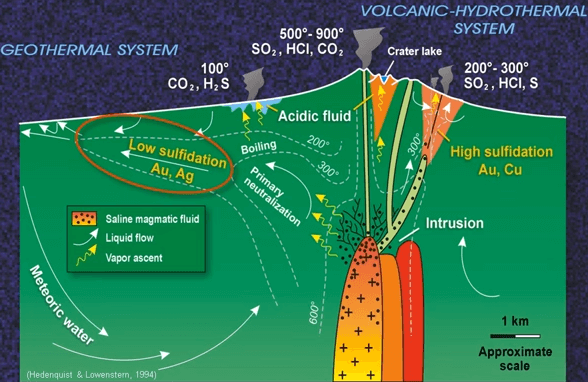 This below is an image of a simple low sulfidation vein system, with all its components preserved, the fluids flow up a single well-defined structures that blossom out near the surface. Alteration is not nearly as pervasive as in a high sulfidation system and seldom extends far beyond the structures unless there’s a permeable horizon and then the fluids may expand along the structure.
This below is an image of a simple low sulfidation vein system, with all its components preserved, the fluids flow up a single well-defined structures that blossom out near the surface. Alteration is not nearly as pervasive as in a high sulfidation system and seldom extends far beyond the structures unless there’s a permeable horizon and then the fluids may expand along the structure. 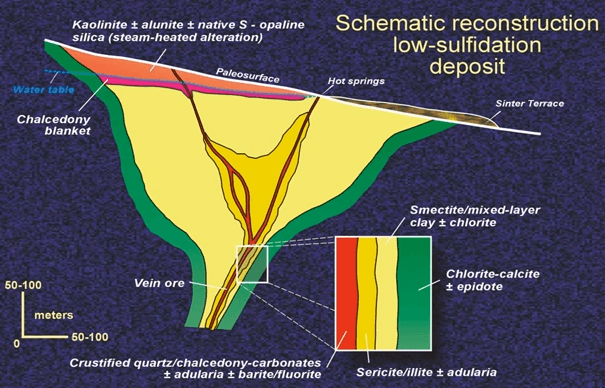 Unlike the muddy acid waters of high sulfidation systems, the low sulfidation fluids are usually crystal clear and have a neutral to slightly alkaline pH. They look good enough to drink but often have high silica, mercury and arsenic contents along with the gold.
Unlike the muddy acid waters of high sulfidation systems, the low sulfidation fluids are usually crystal clear and have a neutral to slightly alkaline pH. They look good enough to drink but often have high silica, mercury and arsenic contents along with the gold.
When the water reaches the surface, it flows out and cools, allowing the silica to drop out a solution to from hard siliceous sinter terraces.
Low sulfidation veins are usually well banded often with alternating layers of silica and carbonates and they frequently show brachiation or open-space filling. More importantly the nature of plates silica replacing calcite which indicates that the fluid boiled. This is just what we are long for as boiling is critical for gold deposition. As in certain ore deposit types, the gold in low sulfidation epithermal fluids is being carried as a fire complex with sulfur.
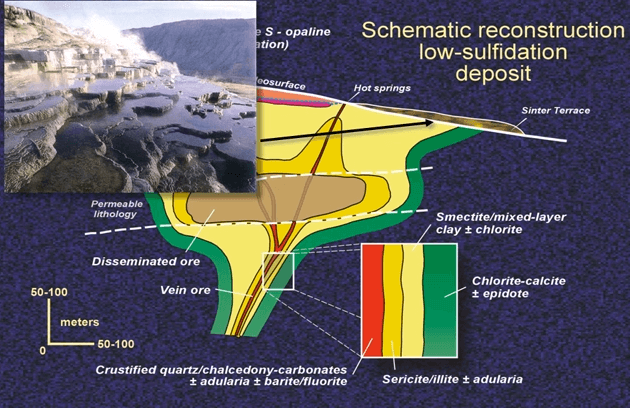 |
 |
 |
|
Earlier on greenstone shear zone hosted gold, where we covered various ways to drop gold from a fire complex solution. I won’t go through this again in detail, but one of the key ways was to break the gold sulfur bond by allowing the fluid to boil, this is the main way in which gold is deposited in low sulfidation epithermal. A reduction of pressure allowing the previously pressure constrained fluids to boil. The boiling zone as it is called, begins at a certain depth below the water table and may extend up to the water table or die out before then.
In the zone you will the evidence of boiling and this where the gold will be. Below the boiling zone the gold will remain soluble and not be significantly deposited, above that zone, much of the gold has already dropped out of solution and the lack of boiling prevents any remaining gold from being deposited. Obviously it’s critical to the economics of the deposit with the boiling zone has a wide or narrow vertical extent, which depends on a number of inputs including:
- the temperature of the fluids
- the amount of ground water mixing
- the rate of flow
- the longevity of the system.
Boiling zones can be anything from 50 meters up to 800 meters thick, with an average of, say about, 300 meters.
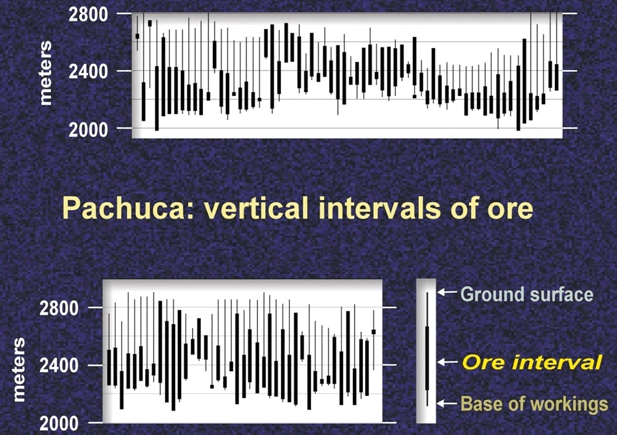 The Pachuca low sulfidation deposit in Mexico, has been mined for many years, so there’s plenty of data to build up a picture of the variability of the boiling zone. The thick black lines in this image represent the vertical extent to the boiling at various points along the strike of the vein. You can see that in this example there is a single boiling zone that averages about 400 meters thick. You may hear the word telescope used in epithermal deposits. This means that the boiling zone moved during the life of the system, spreading the boiling zone over a greater vertical extent. Here are some better- known low sulfidation epithermals that you may have heard of. Notice that, although some of them are typical vein hosted there are some that have developed in more porous rocks and so disseminated rather than vein hosted or controlled.
The Pachuca low sulfidation deposit in Mexico, has been mined for many years, so there’s plenty of data to build up a picture of the variability of the boiling zone. The thick black lines in this image represent the vertical extent to the boiling at various points along the strike of the vein. You can see that in this example there is a single boiling zone that averages about 400 meters thick. You may hear the word telescope used in epithermal deposits. This means that the boiling zone moved during the life of the system, spreading the boiling zone over a greater vertical extent. Here are some better- known low sulfidation epithermals that you may have heard of. Notice that, although some of them are typical vein hosted there are some that have developed in more porous rocks and so disseminated rather than vein hosted or controlled. 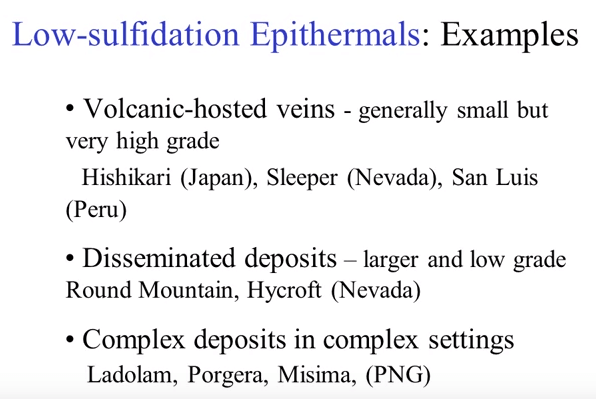 The Hycroft deposit in Nevada is a typical example this.
The Hycroft deposit in Nevada is a typical example this.  The Hishikari mine in Japan exports a swarm of quartz carbonate veins mineralization is very recent and hot water is still flowing from the rocks underground. Here’s an underground view of the vein at Hishikari, not the high grades, typical of this group of deposits.
The Hishikari mine in Japan exports a swarm of quartz carbonate veins mineralization is very recent and hot water is still flowing from the rocks underground. Here’s an underground view of the vein at Hishikari, not the high grades, typical of this group of deposits.
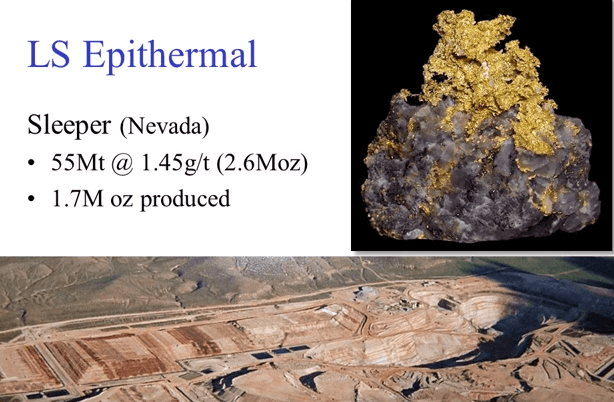 This is the sleeper mine in Nevada, again although the average grade was low, some spectacular gold pockets were encountered. This is one that would be familiar to global investors, Esperanza, San Luis discovery in Peru. High grade gold and silver mineralization occurs in the highlighted series of longish long veins.
This is the sleeper mine in Nevada, again although the average grade was low, some spectacular gold pockets were encountered. This is one that would be familiar to global investors, Esperanza, San Luis discovery in Peru. High grade gold and silver mineralization occurs in the highlighted series of longish long veins. 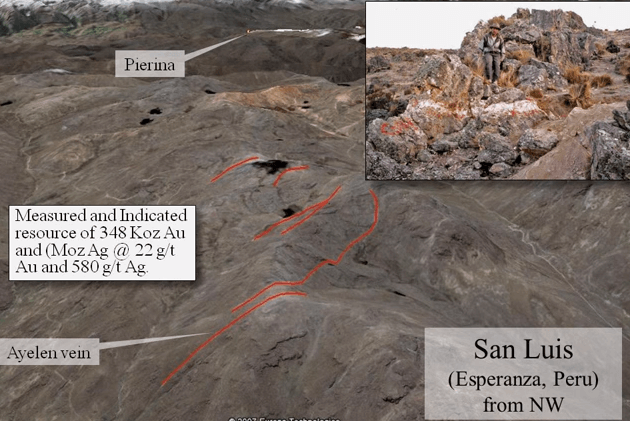 The Pierina can be seen in the distance to the east. On the road the quartz carbonate veins look like this erosion resistant and just a few meters wide. The total size of the deposit is modest, but the excellent grades make up for this, with an average grade of 22 grams per tonne of gold and 580 grams per tonne of silver.
The Pierina can be seen in the distance to the east. On the road the quartz carbonate veins look like this erosion resistant and just a few meters wide. The total size of the deposit is modest, but the excellent grades make up for this, with an average grade of 22 grams per tonne of gold and 580 grams per tonne of silver.  Kinross/Barrick Round Mountain mine, is a 10 million ounce ore body mine from open pit. Because of varying host rocks there are both shallow veins and an underlying blanket of disseminated ore, similar to some of the high sulfidation deposits.
Kinross/Barrick Round Mountain mine, is a 10 million ounce ore body mine from open pit. Because of varying host rocks there are both shallow veins and an underlying blanket of disseminated ore, similar to some of the high sulfidation deposits.
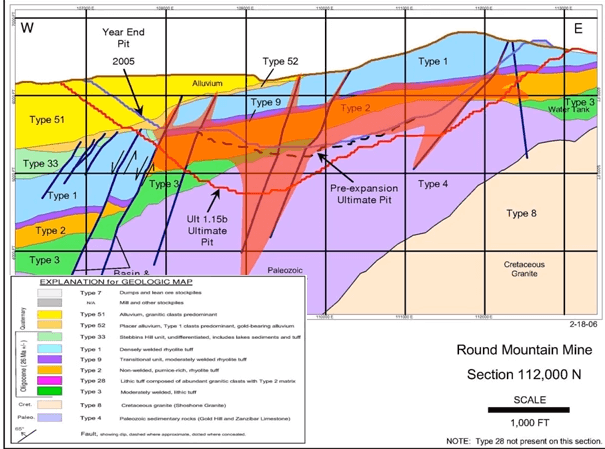 A section through the mine shows the Ore in red developing as veins, the blue welded tuff and its disseminations, the orange pours un-welded tuff and purple sediments below, the ultimate pit out line, is shown as a red line. So much for the low sulfidation epithermals. Now let’s quickly cover the last of the broad groups, the intermediate sulfidation epithermal.
A section through the mine shows the Ore in red developing as veins, the blue welded tuff and its disseminations, the orange pours un-welded tuff and purple sediments below, the ultimate pit out line, is shown as a red line. So much for the low sulfidation epithermals. Now let’s quickly cover the last of the broad groups, the intermediate sulfidation epithermal.
